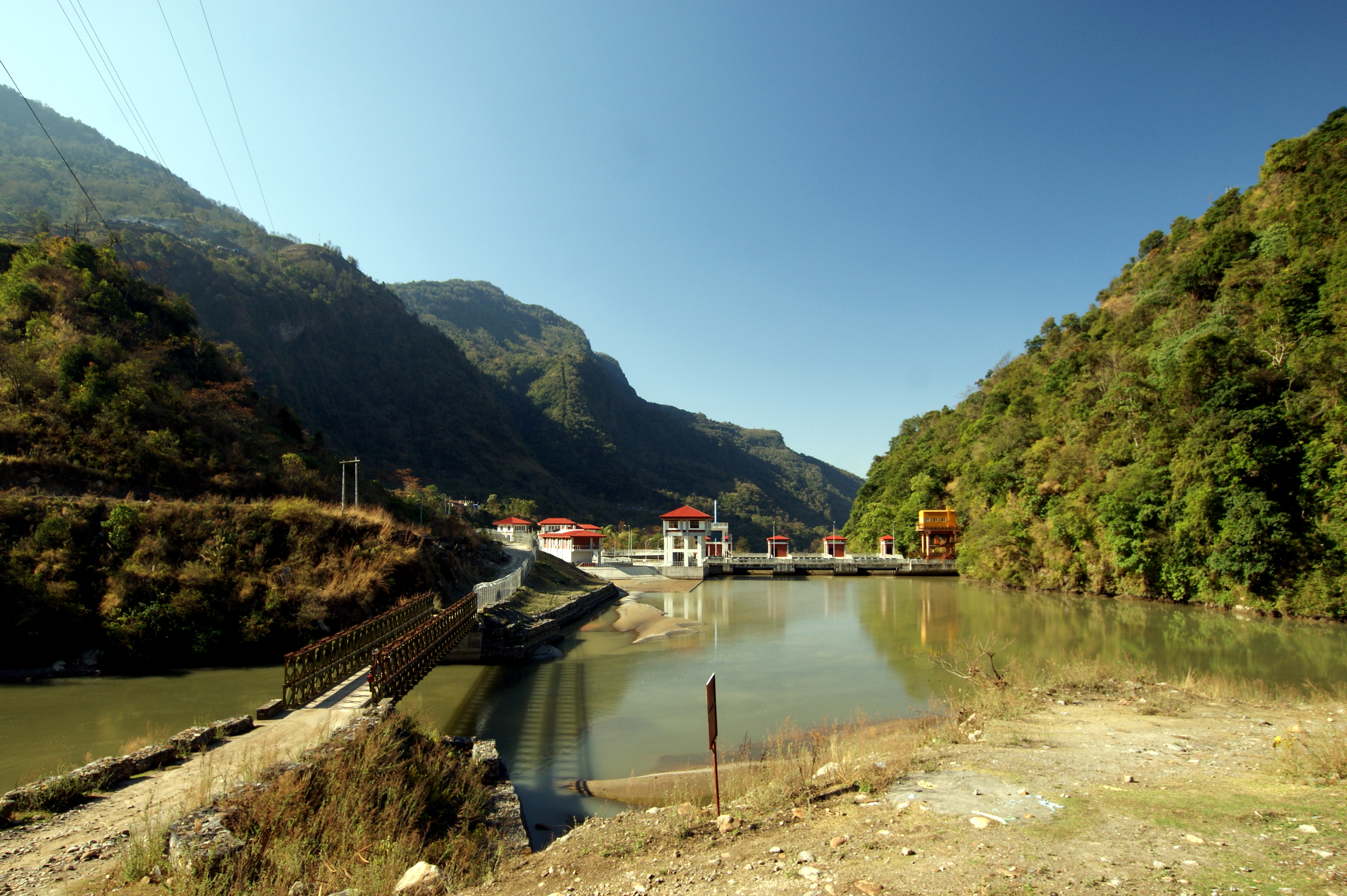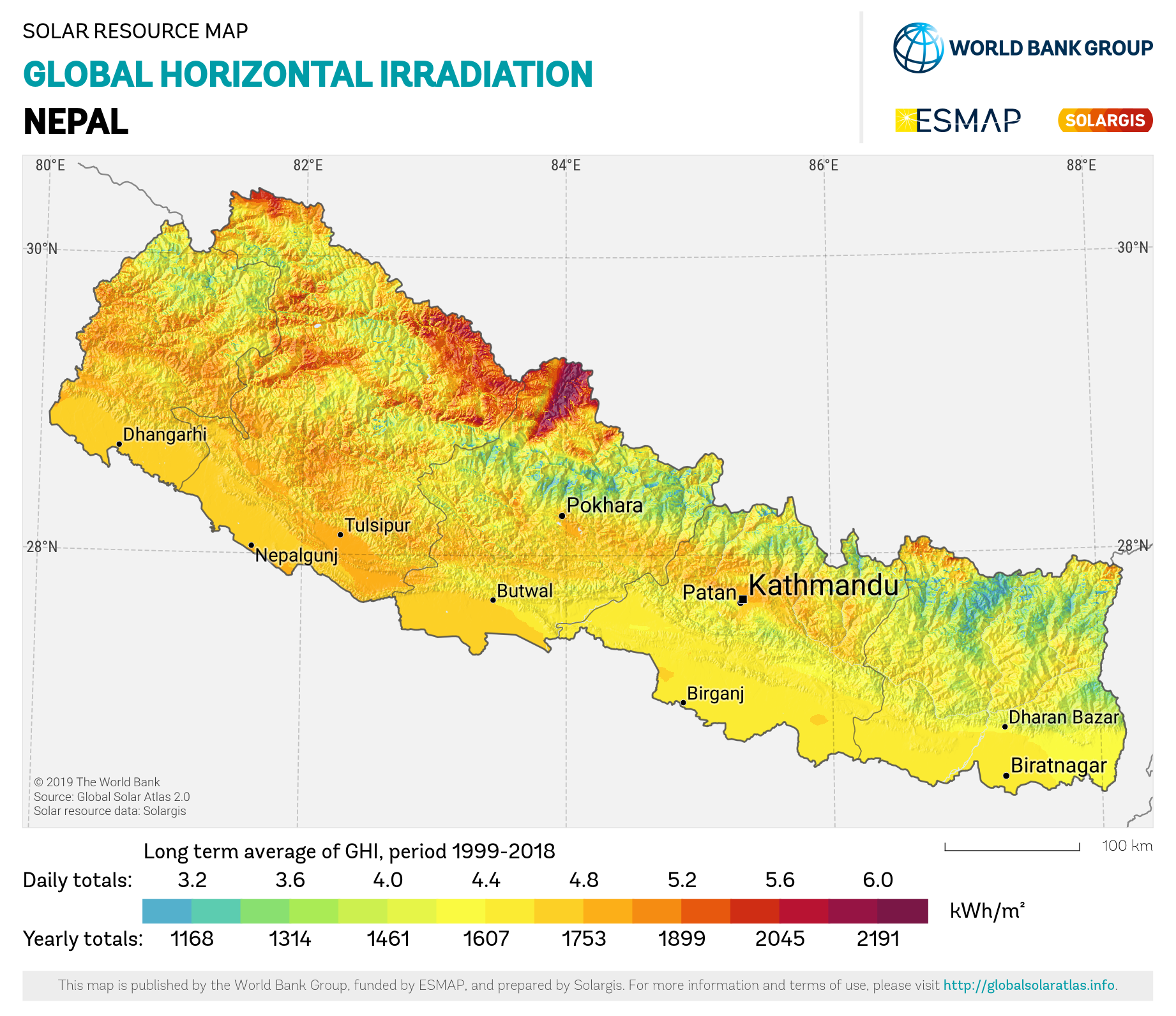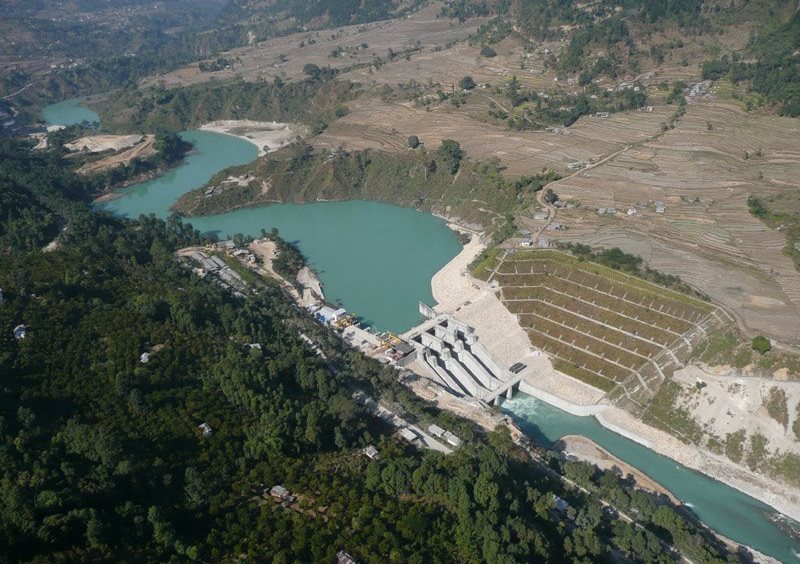|
Butwal Solar PV Project
Butwal Solar PV Project is located at Rupandehi District of Lumbini Province, Nepal. The plant is owned and run by Ridi Hydropower Development Company Ltd, an IPP. The plant came in operation in October 2020. The power station has capacity of 8.5 MW consisting of 32,640 number of solar panels - each generating about 330 watts peak power. The plant occupies an area of about 26 Bighas of land (approx. 17.2 hector). The energy generated by the project is connected to the 33 kV Butwal Substation in Tilottama. The solar station generates energy only during the daytime. The plant was built in 10 months at the cost of NPR 65.5 crores. The loan is financed by Bank of Kathmandu along with Citizens Bank and Nepal Bangladesh Bank. The electricity is sold to Nepal Electricity Authority at rate of NPR 7.3/unit for 25 years. After 25 years, the ownership will be transferred to the Nepal government. See also * List of power stations in Nepal *Nuwakot Solar Power Station Nuwakot Solar ... [...More Info...] [...Related Items...] OR: [Wikipedia] [Google] [Baidu] |
Nepal
Nepal (; ne, नेपाल ), formerly the Federal Democratic Republic of Nepal ( ne, सङ्घीय लोकतान्त्रिक गणतन्त्र नेपाल ), is a landlocked country in South Asia. It is mainly situated in the Himalayas, but also includes parts of the Indo-Gangetic Plain, bordering the Tibet Autonomous Region of China to the north, and India in the south, east, and west, while it is narrowly separated from Bangladesh by the Siliguri Corridor, and from Bhutan by the Indian state of Sikkim. Nepal has a diverse geography, including fertile plains, subalpine forested hills, and eight of the world's ten tallest mountains, including Mount Everest, the highest point on Earth. Nepal is a multi-ethnic, multi-lingual, multi-religious and multi-cultural state, with Nepali as the official language. Kathmandu is the nation's capital and the largest city. The name "Nepal" is first recorded in texts from the Vedic period of the India ... [...More Info...] [...Related Items...] OR: [Wikipedia] [Google] [Baidu] |
List Of Power Stations In Nepal
The following is a list of the power stations in Nepal. Hydroelectric Solar Power Stations Diesel Power Stations Hydropower stations under construction Other Power Stations * Solar power stations ** Simikot 50 kW ** Gamgadhi 50 kW ** Dhobighat Oxidaizing Pond 680.4 kW, Owner:KUKL, Dedicated 11 kV feeder connecting to Teku Substation * 10 other small hydropower stations (total: 2460 * 29 small isolated hydropower stations (total: 5.676 MW) Upcoming Hydro-power Projects in Nepal Source: Bidhyut Magazine/Semi- Annual Report – NEA, Bhadra 2063; NEA Annual Report 2073 B.S. See also *List of largest power stations in the world *List of dams and reservoirs in Nepal References {{DEFAULTSORT:Power stations in Nepal Nepal Economy of Nepal-related lists Energy in Nepal * Power stations A power station, also referred to as a power plant and sometimes generating station or generating plant, is an industrial facility for the generation of ... [...More Info...] [...Related Items...] OR: [Wikipedia] [Google] [Baidu] |
Electric Power In Nepal
Electricity is the set of physical phenomena associated with the presence and motion of matter that has a property of electric charge. Electricity is related to magnetism, both being part of the phenomenon of electromagnetism, as described by Maxwell's equations. Various common phenomena are related to electricity, including lightning, static electricity, electric heating, electric discharges and many others. The presence of an electric charge, which can be either positive or negative, produces an electric field. The movement of electric charges is an electric current and produces a magnetic field. When a charge is placed in a location with a non-zero electric field, a force will act on it. The magnitude of this force is given by Coulomb's law. If the charge moves, the electric field would be doing work on the electric charge. Thus we can speak of electric potential at a certain point in space, which is equal to the work done by an external agent in carrying a unit of posit ... [...More Info...] [...Related Items...] OR: [Wikipedia] [Google] [Baidu] |
Solar Power Stations In Nepal
Solar may refer to: Astronomy * Of or relating to the Sun ** Solar telescope, a special purpose telescope used to observe the Sun ** A device that utilizes solar energy (e.g. "solar panels") ** Solar calendar, a calendar whose dates indicate the position of the Earth on its revolution around the Sun * Solar Maximum Mission, a satellite * SOLAR (ISS), an observatory on International Space Station Music * "Solar" (composition), attributed to Miles Davis * ''Solar'' (Red Garland album), 1962 * ''Solar'' (Taeyang album), 2010 * ''Solar'', a 2011 album by Rubik * "Solar", a song by Northlane from '' Mesmer'', 2017 * SOLAR Records, a record label Geography * Solar (Spanish term), a type of urban site * Solar, County Antrim, Northern Ireland, United Kingdom * Solar, Erode, India * Solar, Iran, Iran Companies * Solar Entertainment Corporation, a Philippines television and radio media company * Solar TV, a former TV channel * Solar Television Network, Inc., a former name ... [...More Info...] [...Related Items...] OR: [Wikipedia] [Google] [Baidu] |
Solar Power In Nepal
Renewable energy in Nepal is a sector that is rapidly developing in Nepal. While Nepal mainly relies on burning biomass for its energy needs, solar and wind power is being seen as an important supplement to solve its energy crisis. The most common form of renewable energy in Nepal is hydroelectricity. Nepal is one of three countries with the greatest increases in electricity access from 2006 to 2016, owing to grid-connected and off-grid renewables. Hydropower According to one estimate, Nepal has a hydropower potential of 83,000 megawatts (MW). Harnessing an estimated 40,000 MW is considered technically and economically feasible. Nepal currently has an installed capacity of 1142 MW coming from 88 hydropower plants across the country. Of this, 441 MW is produced by 60 hydropower plants owned by independent power producers. Most of Nepal's hydropower plants are run-of-the-river, which causes electricity supply to fluctuate according to the season. As of March 2018, as many as 1 ... [...More Info...] [...Related Items...] OR: [Wikipedia] [Google] [Baidu] |
Renewable Energy In Nepal
Renewable energy in Nepal is a sector that is rapidly developing in Nepal. While Nepal mainly relies on burning biomass for its energy needs, solar and wind power is being seen as an important supplement to solve its energy crisis. The most common form of renewable energy in Nepal is hydroelectricity. Nepal is one of three countries with the greatest increases in electricity access from 2006 to 2016, owing to grid-connected and off-grid renewables. Hydropower According to one estimate, Nepal has a hydropower potential of 83,000 megawatts (MW). Harnessing an estimated 40,000 MW is considered technically and economically feasible. Nepal currently has an installed capacity of 1142 MW coming from 88 hydropower plants across the country. Of this, 441 MW is produced by 60 hydropower plants owned by independent power producers. Most of Nepal's hydropower plants are run-of-the-river, which causes electricity supply to fluctuate according to the season. As of March 2018, as many as 11 ... [...More Info...] [...Related Items...] OR: [Wikipedia] [Google] [Baidu] |
Energy In Nepal
Nepal had a total primary energy supply ( TPES) of 10.29 Mtoe in 2012. Electricity consumption was 3.57 TWh. Most of this primary energy (about 80%) represents solid biofuels used in the residential sector (for heating, cooking etc.). About 23% of the electricity is imported, with the rest almost completely supplied by hydroelectricity. Nepal also exports hydroelectricity to India in the wet season. Nepal has no known major oil, gas, or coal reserves, and its position in the Himalayas makes it hard to reach remote communities. Consequently, most Nepali citizens have historically met their energy needs with biomass, human labor, imported kerosene, and/or traditional vertical axis water mills. Energy consumption per capita is thus low, at one-third the average for Asia as a whole and less than one-fifth of the world average. The country has considerable hydroelectricity potential. The commercially viable potential is estimated at 44 GW from 66 hydropower sites. In 2010, the e ... [...More Info...] [...Related Items...] OR: [Wikipedia] [Google] [Baidu] |
Mithila 2 Solar PV Station
Mithila 2 Solar PV Station is a 10 MW solar power plant located at Dhanusha District, Madesh Province; Nepal. The plant is owned and under construction by Eco Global Power Development Pvt. Ltd., an IPP. The plant is planned to come in operation in February 2024. The station occupies an area of about 35 Bighas of land (approx. 26.5 hector). The station has 28,504 solar panels, and three inverters to convert 690 DC to AC. The energy so generated by the project will be connected to the Dhalkebar Substation, which is about 1 Km from the plant. The generated electricity is planned to sell to Nepal Electricity Authority through PPA connecting to National Power Grid System. See also * List of power stations in Nepal *Butwal Solar PV Project *Nuwakot Solar Power Station Nuwakot Solar Power Station is located at Nuwakot District of Nepal. It is the largest solar power plant of Nepal. The plant is owned by Nepal Electricity Authority (NEA). The solar panels are installed in six loca ... [...More Info...] [...Related Items...] OR: [Wikipedia] [Google] [Baidu] |
Nuwakot Solar Power Station
Nuwakot Solar Power Station is located at Nuwakot District of Nepal. It is the largest solar power plant of Nepal. The plant is owned by Nepal Electricity Authority (NEA). The solar panels are installed in six locations within the premises of Devighat Hydropower Station which is also owned by the NEA. Energy generated by the project is connected to the 66 kV sub-station of Devighat Hydropower Station. The solar station generates energy only during the daytime. The Chinese contractor Risen Energy Co. is involved in the operation and maintenance of the plant for the first five years. After that, the plant will be handed over to the NEA. Construction of the station began in 2018. Its targeted construction duration was one year, however there were delays due to environment studies. NEA had planned to install 15MW by April 2020 which was again delayed due to nationwide lockdown to prevent the spread of COVID-19 pandemic. As of June 2020, only 1.25 MW has been installed. The project ... [...More Info...] [...Related Items...] OR: [Wikipedia] [Google] [Baidu] |
Nepal Electricity Authority
Nepal Electricity Authority (NEA), founded on 16 August 1985, is the parent generator and distributor of electric power under the supervision of the government of Nepal Nepal (; ne, नेपाल ), formerly the Federal Democratic Republic of Nepal ( ne, सङ्घीय लोकतान्त्रिक गणतन्त्र नेपाल ), is a landlocked country in South Asia. It is mai .... NEA owns Hydroelectric Plants connected to the grid amounting to 480 Megawatts. It also buys power from Independent Power Producers (IPP) amounting to 230 Megawatts. It operates two fuel operated plants generating 53 Megawatts of Electricity. The total capacity of the Integrated Nepal Power System (INPS) which NEA operates stands at 1095 Megawatts. Various projects are underway to help meet the electricity demand but these have been plagued by delays. However after many such delays Nepal has seen a positive change in electricity production and distribution. For the ... [...More Info...] [...Related Items...] OR: [Wikipedia] [Google] [Baidu] |
Butwal
Butwal ( ne, बुटवल), officially Butwal Sub-Metropolitan City ( ne, बुटवल उपमहानगरपालिका), is a sub-metropolitan city and economic hub in Lumbini Province in West Nepal. Butwal has a city population of 195,054 as per 2021 Nepal census. The city is one of the tri-cities of rapidly growing Butwal- Tilottama-Bhairahawa urban agglomeration primarily based on the Siddhartha Highway in West Nepal with a total urban agglomerated population of 421,018. It is one of the fastest-growing cities in Nepal for health, education, construction, communication, trade, and banking sectors. It has highway connections to the Indian border at Sunauli and to the hilly towns in Tansen and Pokhara valley, and holds the title of being "The Best City in Nepal" five times in a row. Geographically, Butwal is at the intersection of Nepal's two different National Highways, Mahendra Highway and Siddhartha Highway. It connects western Nepal with the capital Kathm ... [...More Info...] [...Related Items...] OR: [Wikipedia] [Google] [Baidu] |
Nepal Bangladesh Bank
Nepal Bangladesh Bank Ltd. ( ne, नेपाल बाङ्लादेश बैंक) also known as NBB ( ne, एन.बी.बी.) or NB Bank was a public owned commercial bank in Nepal. It was established in June 1994 with an authorized capital of Rs. 240 million and paid up capital of Rs. 60 million as a joint venture Bank with IFIC Bank of Bangladesh. The Nabil Bank Ltd. successfully acquired Nepal Bangladesh Bank Ltd. hence starting a joint venture A joint venture (JV) is a business entity created by two or more parties, generally characterized by shared ownership, shared returns and economic risk, risks, and shared governance. Companies typically pursue joint ventures for one of four rea ... from 11 July 2022. The bank will further operate in the name of Nabil Bank Limited. Its head office is at Kamaladi-28, Kathmandu. It had a network of 111 branches, 8 Extension Counters, 5 Branchless banking, and 87 ATM terminals. It also provides e-banking and mobile bankin ... [...More Info...] [...Related Items...] OR: [Wikipedia] [Google] [Baidu] |




